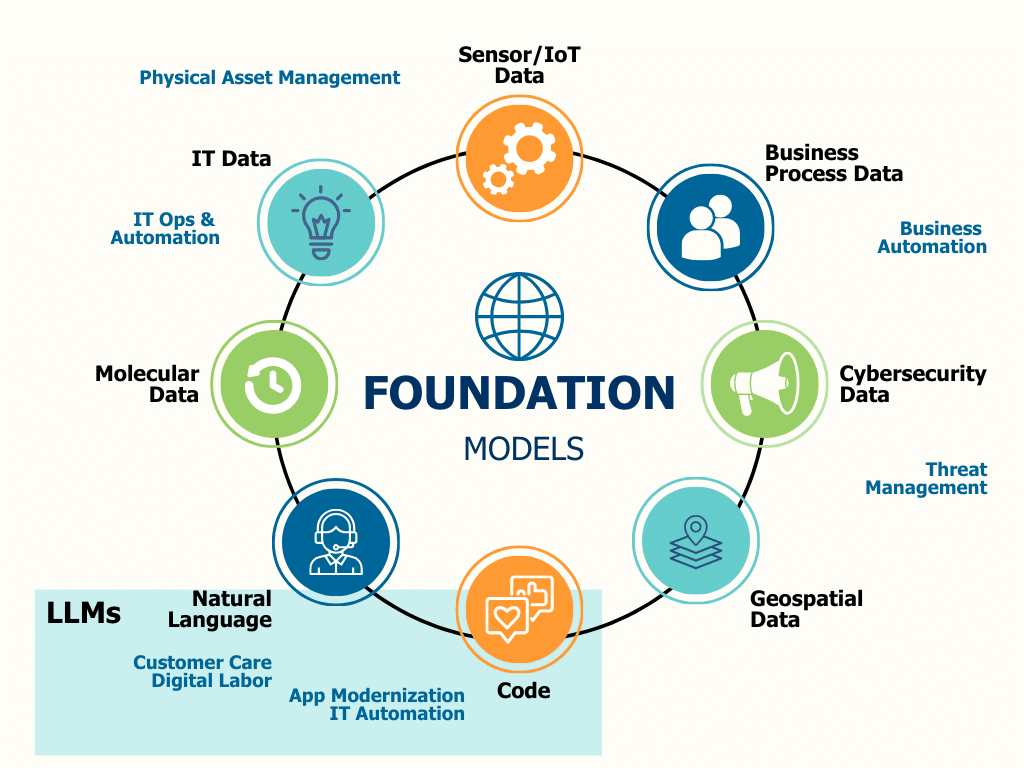In today’s ever-evolving landscape of artificial intelligence (AI), Generative AI (Gen AI) stands as a remarkable breakthrough—unlocking a world of possibilities across industries. It’s about creating something new, something unprecedented—a realm of limitless creativity. Think of it as an artist’s canvas, where AI paints with text, images, code, or even sound.
Generative AI is reshaping how humans and machines collaborate, enabling innovation through intelligent automation and creativity at scale. To understand how it works, let’s explore its fundamental components.
Foundation Model (The Brain)
The foundation model, often referred to as “the brain” of Generative AI, is its cornerstone. These large-scale, pre-trained AI models are infused with massive datasets containing diverse knowledge and context. This extensive foundation enables Generative AI to create, generate, and innovate efficiently.

The power of foundation models lies in their adaptability—they can be fine-tuned or specialized for specific use cases, making them far more versatile than traditional, task-specific AI systems.
For example, ChatGPT—powered by different generations of foundation models—supports a wide range of intelligent interactions. These models are trained on data at an “internet scale,” far exceeding the capacity of any single organization to replicate, ensuring vast knowledge coverage and advanced reasoning capabilities.
Applications vs. Models
Think of foundation models as the brains and applications as the user-friendly interfaces. When you interact with applications like ChatGPT, you’re engaging directly with the underlying foundation model developed by OpenAI.
This concept extends across various AI domains—text, code, images, and speech—each supported by its own category of foundation models. The synergy between models and applications fuels the next generation of intelligent tools that can understand, create, and learn.
The Prompt (Guiding Instruction)
The prompt is your guiding instruction in the world of Generative AI. It’s the input—the nudge—that directs the AI to generate something meaningful, insightful, or creative.
- A “prompt” is a short instruction or query given to a Generative AI model to shape its response.
- It acts as a bridge between human intent and machine creativity.
- Prompts are concise, purposeful, and designed to elicit a specific kind of output.
- In simple terms, prompting is like asking a question or giving a directive to the AI.
Well-crafted prompts can drastically improve the quality, tone, and precision of AI-generated outputs, making prompt design an essential skill in today’s AI-driven world.
Prompt Engineering
Prompt Engineering is the art and science of crafting effective inputs that guide AI models to generate optimal results. It marks a major shift in programming—from writing complex code to simply communicating with AI using natural language.
This evolution highlights the growing role of language-driven automation, simplifying how we instruct AI to generate code, text, or other forms of content effortlessly.
- “Prompt engineering” goes beyond simple input—it involves strategically refining prompts to achieve specific outcomes.
- It may require experimentation with different wordings, structures, and contextual clues.
- The goal is to optimize output quality, relevance, and accuracy, making AI responses more aligned with user intent.
In essence, a prompt is the initial instruction, while prompt engineering is the deliberate refinement process that ensures precise, high-value interactions with AI systems.
The Creation (Tangible Value)
The true magic of Generative AI happens in the creation phase—the tangible outcome derived from the model’s reasoning and knowledge. The AI uses its vast understanding to craft something innovative and useful based on your prompt.

Whether it’s generating business insights, writing content, designing visuals, or automating workflows, this stage delivers real, measurable value to individuals and enterprises alike.
How Generative AI Differs from Traditional AI
As Greg Hodgkinson, CTO and Head of Engineering at Prolifics, insightfully explains in his blog “With Generative AI, AI Becomes Bigger and Better,” the evolution of AI represents a paradigm shift.
Traditional AI required vast, labeled datasets to train models for one specific task—a resource-intensive, costly process that offered limited ROI.
Generative AI, on the other hand, leverages foundation models that can perform multiple tasks with minimal retraining. This adaptability makes AI implementation more accessible, scalable, and cost-effective for businesses of all sizes.
The Impact on Businesses
Generative AI introduces a transformative approach to AI for enterprise applications. It promises not only a stronger return on investment but also enables the rise of specialized foundation models—custom-tailored for specific industries like healthcare, finance, manufacturing, and retail.
Organizations are increasingly pursuing AI autonomy, integrating these technologies within their cloud or on-premises environments. This is made possible through platforms designed for foundation model interactions and advanced prompt engineering tools.
As Generative AI continues to expand, enterprises worldwide are embracing its limitless capabilities to drive innovation, boost productivity, and reimagine business models. The future is open, dynamic, and ready for your creative touch—the canvas of Generative AI awaits your next idea.




